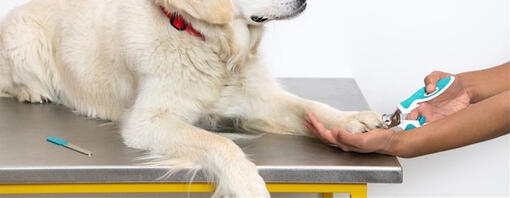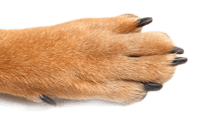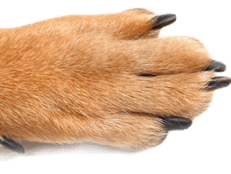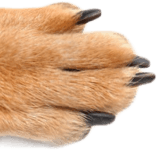
When it comes to grooming your dog, nail care might not be the first thing that comes to mind — but it’s more important than you might think. Over-grown nails don’t just look untidy; they can cause discomfort for your dog and even lead to long-term health issues. So, how do you know if your dog needs their nails trimming, and should you tackle nail trimming at home? Let's dig into the details.
Cutting Your Dogs Nails: Why is it so Important?
Nail care is an important part of grooming and health care, though not all dogs need their nails trimmed regularly or even at all. Whether trimming is necessary depends on factors like your dog’s exercise environment, how they move, and their individual conformation. While most active dogs naturally wear their nails down, others may still need occasional attention. For those dogs with dew claws, these can often benefit from a trim – especially if they are prominent, get sharp, or tend to get caught on things. While it might seem like a small detail, looking after your dog's claws by making sure they are the correct length, plays a big role in their overall health and happiness.
Preventing Pain and Discomfort
If your dog’s nails get too long, even a simple walk can become uncomfortable. The extra length forces their paws and joints into unnatural positions, which can lead to soreness and discomfort. Over time, this misalignment can contribute to long-term chronic conditions affecting joints, posture, and mobility – as well as having a detrimental effect on your dog’s enjoyment of walks and exercise.
Avoiding Joint and Posture Issues
Overgrown nails can affect the way your dog walks, shifting pressure to the wrong parts of their feet. This unnatural posture can strain their joints over time — especially in older dogs, who may already have mobility concerns or younger dogs who are still growing and developing.
Take a look at our expert tips for grooming tips for senior dogs for more advice.
Reducing the Risk of Snags and Breaks
Longer claws are also more likely to chip, tear, split or break and these injuries are often painful, requiring a trip to the vet.
Protecting Your Floors and Furniture
If you can hear your dog’s claws on the floor or if you’ve spotted snags on the sofa or feel them catching your clothing, you’ll know that long dog nails can leave their mark — literally. Keeping your dog’s nails trimmed can help protect your home from damage.
How Long Should a Dog's Nails Be? Signs They Are Too Long
Not sure if it’s time for a nail trim? This is something you should be keeping an eye on every time you take your dog out for a walk. Keep in mind that while most dogs' nails may touch the ground naturally and will wear down on pavements and paths, due to their breed or conformation some others might not. If you can hear your dog’s claws on flooring when you usually can’t, if they are catching on things, or if they just seem to be looking longer than usual, they might well need a trim. If you’re not sure, pop into your vet practice and one of the vet nurses should be able to advise you if it’s time for a pawdicure.
It is impossible to say exactly how often your dog will need their claws clipping. Most active dogs wear their claws down on their day-to-day exercise – whereas others might need more claw care – especially if less active, elderly or only walked on soft ground. A very rough guide is that when your dog is standing still, their nails shouldn’t touch the ground; ideally, they should sit just slightly above the surface (about 1mm), only touching the ground when walking or running. But this differs in different breeds and different individuals. Look for signs like clicking sounds on floors, claws catching on things or just feeling more prominent than usual or in extreme cases, your dog walking awkwardly.
Should you clip your dog's nails yourself?
In most cases, especially if you are inexperienced, it’s best to leave it to a professional. While some owners do trim their dog’s nails at home, it’s very easy to cut too far — especially with dark nails — which can cause extreme pain, bleeding, long-term anxiety around paw handling, and a loss of trust in their owner. A vet or professional groomer has the experience to do it safely, quickly, and can assess whether your dog even needs a trim in the first place. If you are keen to learn how to do it yourself, ask them to show you how to do it properly and build your confidence step by step.
How to Trim Dog Nails for Beginners
The safest option is to have your dog’s nails trimmed by a vet or professional groomer, as they know how to avoid cutting the quick — the sensitive part of the nail that can cause pain and bleeding if nicked or cutting them too short. But if that’s not possible, we’ve got some helpful tips to guide you and help you nail it at home.
What Tools Do I Need to Cut My Dogs Nails?
When it comes to nail care, the right tools — and the right approach — makes all the difference. Whether you’re using a grinder or nail clippers, choosing a tool that is best for your dog and that you feel confident using is key.
A grinder reduces the risk of cutting off too much (although you can still always grind too much) but has the disadvantage of making getting the angle right harder, and also it is noisy, and some dogs don’t like the vibration.
Clippers are quicker and quieter but there is more danger of cutting the quick, causing extreme pain and bleeding – and still require you to get the right angle.
Whichever you choose, here’s how to set you and your dog up for success:
Step 1: Learn From a Pro
Before picking up a nail grinder or clippers, ask your vet, vet nurse, or groomer to walk you through the basics. A quick demo can help you feel more confident when it’s your turn. This should not be done with your own dog if you have not got them used to the equipment and paw handling first.
Step 2: Get Your Dog Used to Having Their Paws Handled
Long before you think about clipping your dog’s nails, they should be happy having you handle and then hold their paws. This is something you should be starting right back in puppyhood or as soon as you get your dog as part of your life skills training – but it’s never too late to start.
Paws are very sensitive for most dogs and so this is a slow steady process to ensure they are happy with you handing their feet.
Step 3: Introduce the tools
Whichever tools you decide to use, introduce them to your dog before you need to use them to trip their claws. If you are using clippers, let your dog see them and get used to you holding them around their paws. When they are happy, place the clippers in position to cut the nail several times and reward your dog. Do this on every nail and with every foot. Again, this can take a while before your dog is happy with this – and while you work out how to hold your dog, their paw and the clippers!
If you are using a grinder, you will have to introduce the noise too along with letting them feel the vibration with the grinder cap on.
Use lots of reward – and ideally have someone to help you who can distract your dog with a tasty treat.
Step 4: Find the Right Position
This practise time gives you a chance to find a good position that feels safe and secure for both you and your dog. The goal is to be able to keep them still while helping them feel secure and not restrained. Sitting on the floor beside them usually works well but it depends on your dog – and your own dexterity. Whatever approach you take, focus on creating a relaxed environment where you can reach their paws comfortably. This is best done when your dog is relaxed and calm – not when they are full of energy!
Step 5: Start slow
When you are both happy, you can start to clip those nails. Start with doing one nail only in the first session. This will help build your confidence and your dogs. Always err on the side of caution – as it’s better that you clip them too long than too short.
Even when you become an expert, doing one foot at a time is better for you both than having a marathon session and expecting to get them all done at once.
Step 4: Use Positive Reinforcement
Treats and praise are your best friends here — rewarding your dog after each paw or each nail (depending on which will keep your dog most settled can help them associate nail care with something positive. Having someone with you to distract your dog and help keep them steady can make a big difference, especially in the early stages.
Things To Avoid When Clipping Your Dogs Nails
Even with the best intentions, a few common mistakes can turn nail trimming into more than just an 'unpleasant' experience for you and your dog; it can lead to a loss of trust in your hands, fear of having paws and legs handled, and provoke an aggression reaction. Here’s what to avoid:
- Cutting too short and hitting the quick.
- Trimming at the wrong angle.
- Using dull or inappropriate tools.
- Trying to do too much too quickly.
- Not taking time to introduce tools.
Explore our essential dog first aid guide and learn how to act quickly and confidently in an emergency.
Do Most People Cut Their Own Dog's Nails?
The majority of dogs probably never need to have their nails cut but for those who do, some owners do feel confident trimming their dog’s nails at home, whereas many prefer to leave it to professionals. In most cases, the best practice is to visit your vet and ask one of the vet nurses for help or guidance. Alternatively, a professional groomer can take care of it safely and efficiently – and will be able to give you guidance if you want to do it yourself in the future.
If you're ever unsure, it's always better to ask — your dog (and their paws) will thank you for it!
How to Cut Dog Nails that are Black
Black nails are trickier to manage, simply because the quick is impossible to see through the nail in the way you often can in lighter nails - and that increases the risk of cutting too short. If your dog has black nails, definitely consider taking them to a professional groomer or vet to avoid any unwanted pain and stress for your dog. However, if you still prefer to cut them yourself then bear the following in mind.
When using a grinder or after a careful initial clip, you might notice a white or greyish inner core appear, this is sometimes called the “horn” and can help indicate where to stop. Just beyond that is the quick, so it’s important not to clip any further and look for the white "horn".
What To Do If Your Dog Won't Let Anyone Clip Their Nails?
If your dog resists nail trimming, you're not alone. Anxiety, fear, or past negative experiences can make it a real challenge — and forcing it can damage both your dog’s trust and wellbeing. For other dogs, they’ve never had their paws handled before and can get really worried about it. In these cases, it's best to work with a qualified behaviourist who can work with you and your dog to get them comfortable being handled around the feet and claws and slowly build up to trimming their nails.
Sedation should only be considered in extreme situations, such as with rescue dogs or when the nails pose a serious health risk. With the right behavioural support and patience, even the most fearful dogs can learn to feel more at ease.
In many cases however, re-thinking where you walk your dog can make all the difference. By including regular pavement walking, most dogs will wear down their claws during their day-to-day exercise.
When Should You Seek Professional Help?
The general advice is to always leave nail care to professionals. However, there are a few signs when it's crucial to get that extra support:
If Your Dog Becomes Aggressive or Too Anxious
If nail trimming or handling legs and feet leads to growling, snapping, or extreme stress, get advice from an accredited qualified behaviourist. Never try to force your dog as this will just make things far worse in the future.
If Their Nails Are Extremely Overgrown
Dogs from rescue situations or those who’ve experienced neglect may have severely overgrown nails, which can be painful and difficult to manage. In these cases, trimming at home can be risky, as long nails are more likely to have an extended quick, increasing the chance of injury. Most rescue centres will have dealt with this as part of their pre-homing but if not, your vet can help get your dog’s nails back into a healthier shape safely and gradually, ensuring the process is as stress-free and comfortable as possible.
If You’re Unsure About the Proper Technique
Not confident where to cut or which tool to use? A quick visit to your vet or groomer can give you the guidance and peace of mind you need.
Want to keep your pet happy and healthy? Don’t miss our tips on caring for our pets’ health.
FAQ
It’s best to avoid this altogether. Human nail clippers aren’t built for the shape or thickness of dog nails, and using them can lead to splitting, crushing, or discomfort. For a safer, smoother trim, always use clippers specifically designed for pets.
Always trim at a slight angle, following the natural curve of the nail and angle of the paw. Avoid cutting straight across, as this can create pressure points or lead to splitting. Aim to take off a small amount at a time. You can always trim more, but you can’t undo a cut that goes too far.
While there’s no magic trick – just time and patience.
Start by gently handling your dog’s paws regularly, pairing this with treats and praise. Become familiar with the nail care tools yourself before you start. If you are trimming their nails on your own, you can use distractions like a lick mat - and always keep nail trimming sessions short. With patience, time and professional guidance, you can ensure your dog’s nails are always in tip top condition.





